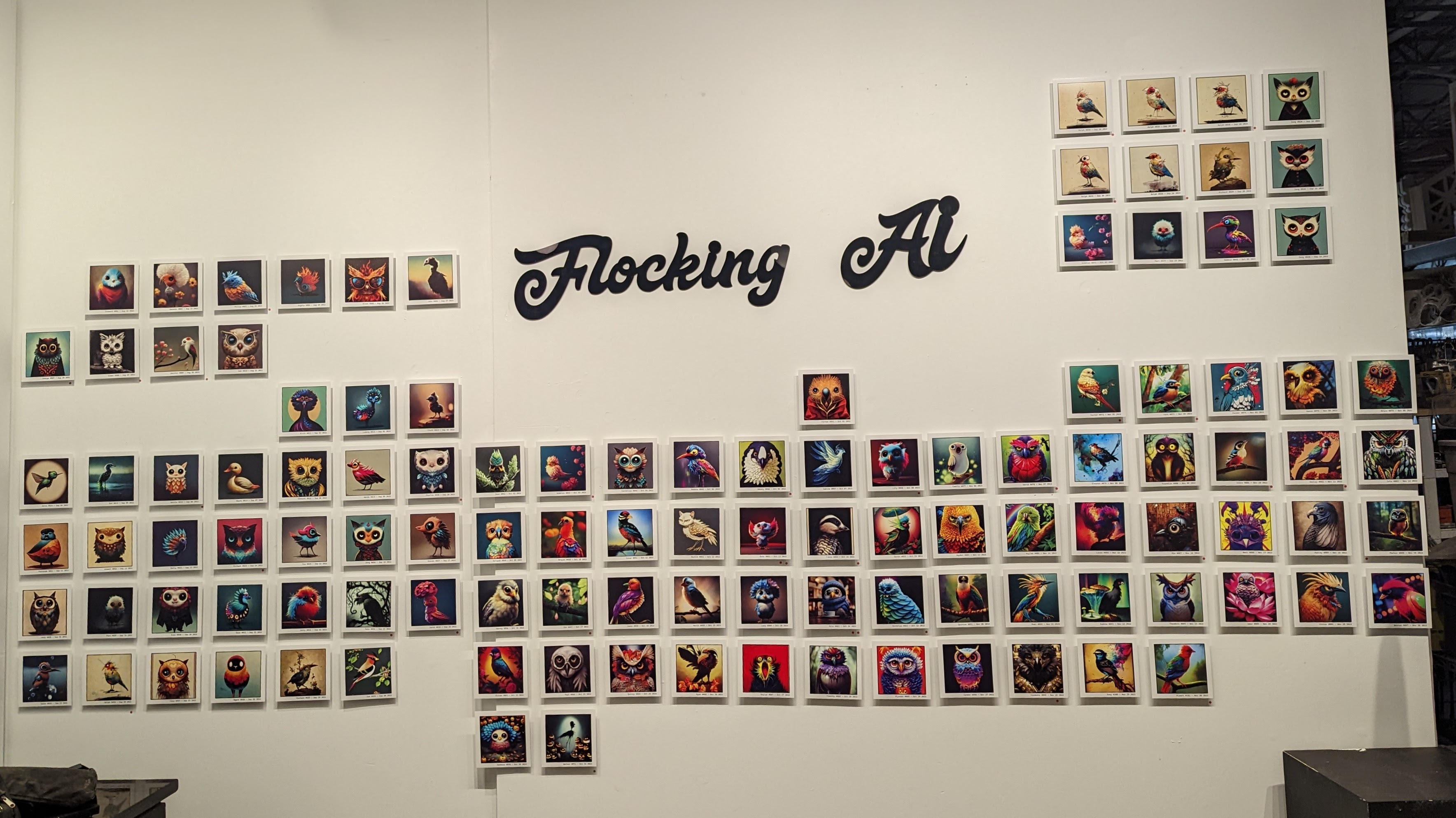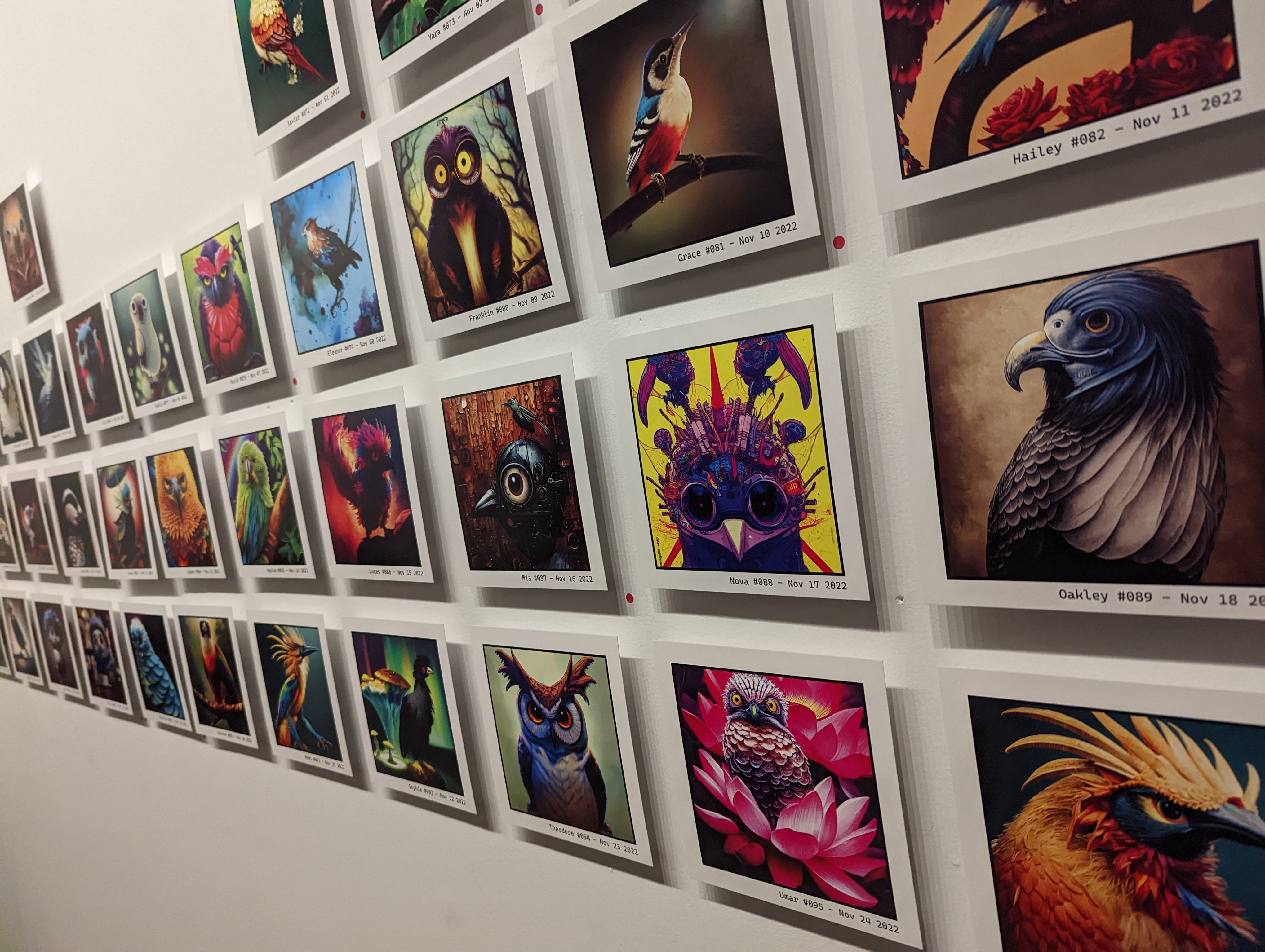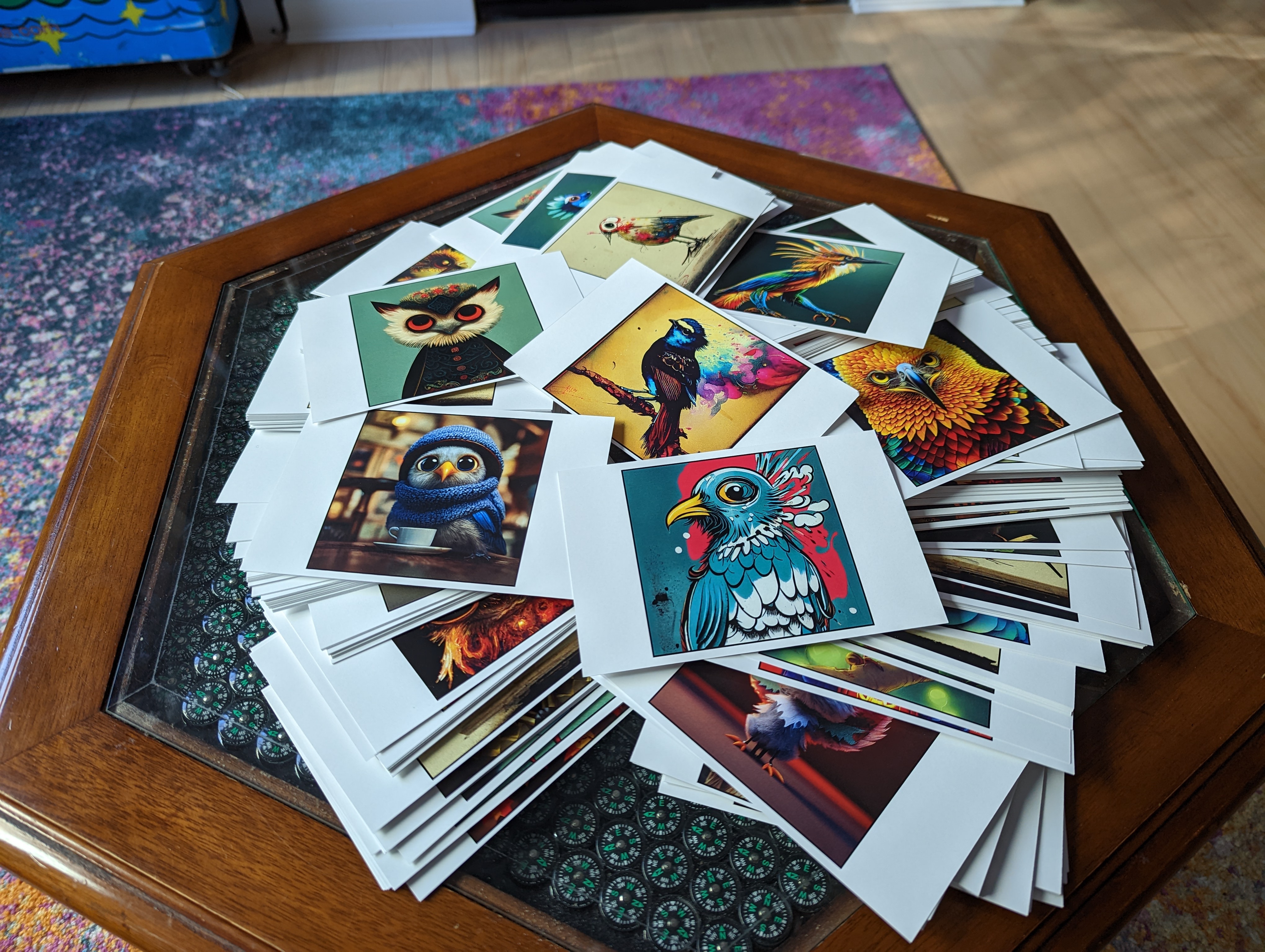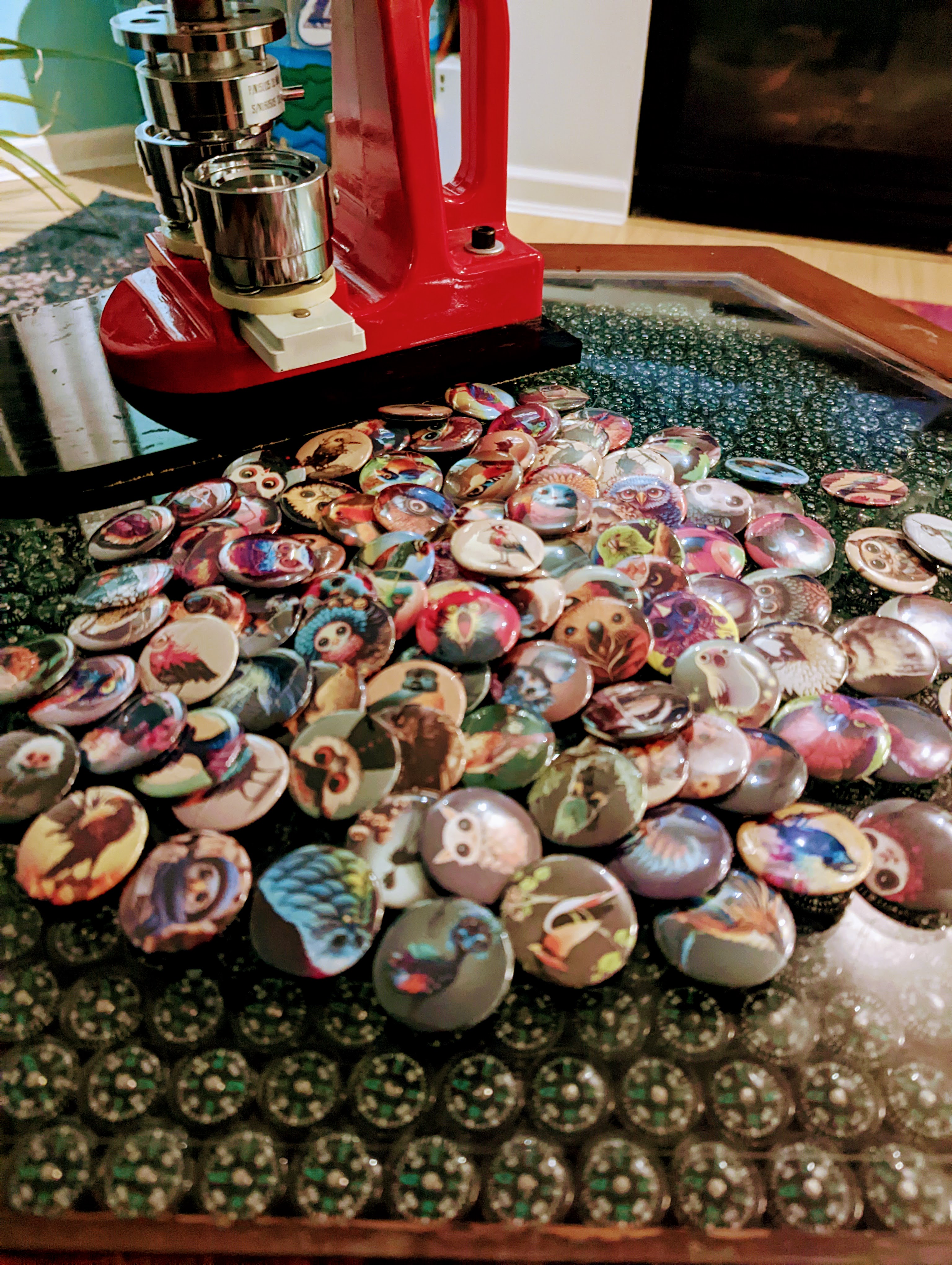FlockingAI - Eastside Culture Crawl 2022 post mortem
Most mortem for the Flocking AI project at Maker labs for Eastside Culture Crawl on November 28th, 2022
The Gallery Wall
 I set up the photos on the wall to look like a calendar. Each month to show that this project was calendar based. The width of the wall made it so I could not add a buffer horizontally between calendar months. Most people saw the design and thought of a periodic table of birds.
I set up the photos on the wall to look like a calendar. Each month to show that this project was calendar based. The width of the wall made it so I could not add a buffer horizontally between calendar months. Most people saw the design and thought of a periodic table of birds.
The whole series of photos were 6 inches lower than I was planning. This happened because I miscounted the number of weeks/rows in each month as 6 instead of 5 when I started in the bottom left. October has 6 rows, while every other month only has 5. This turned out to be a good thing as the photos higher up (such as August) were much harder to see, especially by children.
 The first bird that most people saw was Milo (Knitted Sparrow) because it is centered and child height. When parents would ask their children what their favorite one was, it was the first cute one that they saw. It looked the most like a Pixar character. It was also one of the most anthropomorphized (human looking) looking one because of the knitted scarf and coffee cup. It quickly became the most popular bird by far. Because of its popularity I used it as the example in my main pitch, and that also increased its popularity.
The first bird that most people saw was Milo (Knitted Sparrow) because it is centered and child height. When parents would ask their children what their favorite one was, it was the first cute one that they saw. It looked the most like a Pixar character. It was also one of the most anthropomorphized (human looking) looking one because of the knitted scarf and coffee cup. It quickly became the most popular bird by far. Because of its popularity I used it as the example in my main pitch, and that also increased its popularity.
I didn’t have the banner for Thursday, Friday but was able to make it early Saturday morning. I think the banner really ties the gallery wall together. It also gives people a clue what this project is about, and giggles to people who like the play on words.
I spent a lot of time working on how the prints would look on the wall. It would have helped if I was able to add a few bios to the wall as well. It would show that there is more to this project then just the pretty photos.
 In the bottom right corner, I had a few sheets of paper with information about this project. Including QR codes to where they could see the social media pages or find more information about. These helped a ton as people could quickly share the information with people who were not there. But they looked ugly. I wish I thought of a better way to display them. These sheets were also too close to the ground, everyone had to bend over to take a photo of it or read it.
In the bottom right corner, I had a few sheets of paper with information about this project. Including QR codes to where they could see the social media pages or find more information about. These helped a ton as people could quickly share the information with people who were not there. But they looked ugly. I wish I thought of a better way to display them. These sheets were also too close to the ground, everyone had to bend over to take a photo of it or read it.
I purchased a postcard display rack from Staples on Friday. This helped significantly show that there were postcards for sale that people could buy. This is a definite must for next time.
 There were 104 different postcards, they were in no particular order and even if they were, people wouldn’t have returned them to any order. This turned out to be a good thing as people would start searching for the one that they wanted and see a bunch of other ones that they wanted along the way. People ended up buying more quantity because of it.
There were 104 different postcards, they were in no particular order and even if they were, people wouldn’t have returned them to any order. This turned out to be a good thing as people would start searching for the one that they wanted and see a bunch of other ones that they wanted along the way. People ended up buying more quantity because of it.
The lighting in MakerLabs’s gallery was unfortunately dim because the other person that was using the gallery wall next to me turned off the lights to show their lamps better. Compromise. It made photos of the whole gallery wall harder to do. This produced worse photos in social media from random people.
For the buttons. I used a big steel plate and put magnets on the back of each button and stuck it to the metal plate. I think that worked really well. The problem was that I had nowhere to put this big metal plate so it had to sit on the floor. Great for attracting children but not very presentable.
Demographic - The people
It was most popular with 20-40 year old women, and men older than 50 looking for gifts. They bought over 80% of all the prints and postcards. Men between the ages of 20-40 quickly looked at it and either knew something about AI art and dismissed it or were really interested in talking to me about it. The project didn’t do well with children who looked at the birds and quickly got distracted by something else.
Main Pitch
This is the main pitch that I settled on after a few conversations with people.
This is a project of two robots talking to each other. The first robot is a chatbot that I created using OpenAI. I fed the chatbot all the encyclopedia entries of birds on Wikipedia, then a bird ID book, and a bunch of bird jokes. What this created as the most enthusiastic bird nerd that you have ever met. All it wants to talk about is birds.
I had a conversation with this robotic bird nerd and asked a few stock questions.
I showed a sheet of paper with the conversation used to create Milo (Knitted Sparrow)
We are creating a new field guide to birds with imaginary birds. First, we need to start with a new species name. Which do we call this new bird species? The robot replied with; the new species name is “knitted sparrow”.
I asked, what does it eat? and does it have a favorite food? The robot responded with insect seeds and berries but has a particular fondness for coffee beans.
I asked a bunch of other genetic questions Like, what’s its habitat? What does it nest look like? How many eggs does it have? Where does it live? Do they have any natural predators? etc. etc…
What do you call a flock of these birds? A dark roast… Pause for laughter
Then I asked the robot to take our conversation and compile it into a small paragraph. A unique biography for this bird. This block of text is completely written by a robot and not written by a human.
Then I take that block of text and pass it to the “text to image” generator called MidJourney. MidJourney generates a picture based on the bio.
Each bird has their own unique story and bio associated with it. A new bird is generated every single day and posted to social media Facebook, Twitter and Instagram.
This pitch worked well and goes over most of the main points of the project. Giving people context in the project shows that I am not just typing prompts into Mid Journey. It showed people that there was more to this project (the bio) then they could see on the wall.
It didn’t have any natural questions that people could ask me at the end. I think this was a mistake as it was hard to continue the conversation after the pitch. It felt like I was talking to them more than having a natural conversation.
It also threw me when someone interrupted me during the pitch with a question. It broke the flow of the pitch and I found it hard to continue with the same enthusiasm afterwards.
What worked
- Using foam to add a spacer between the wall and the print
What didn’t work
- Organizing the prints on the wall like a calendar.
- My main pitch didn’t allow for natural questions.
Things I would do differently next time
- Add the bird species name to the prints.
- Add the bird bio to the back of the print.
- Add an infographic telling people that it was okay to take a photo of the wall. Many people asked and I suspect that just as many people didn’t feel comfortable asking. I want people to take photos and share.
- Have a laptop with the chatbot running so people can play with it.
Sales
Prices were
- Buttons: 1 for $2, 3 for $5
- Postcards: 1 for $3, 5 for $10, Full Set of 101 for $175
- Prints: 6”x6” for $10
I sold 65 buttons, 197 postcards, 41 prints over 4 days.
| Amount | Type |
|---|---|
| $218 | Cash |
| $54 | Etransfers (10) |
| $410 | Prints ($10*41) |
Sub total income: $682
I priced everything very cheap so anyone that wanted one could afford it. I remember going to Culture Crawl in past years and being surprised at how expensive everything was. I was also feeling guilty that I was profiting off of an ethically dubious AI art.
I did not have the ability to accept credit cards. All the income came in the form of cash or E-Transfers. I was surprised at how many people have E-Transfers set up on their phones ready to send people money. I turned away quite a few people when they didn’t have cash or the ability to send an E-Transfer. I estimate that I could have made another ~$300 if I accepted credit cards.
I didn’t want to set up a square machine to accept credit card interactions because I didn’t want the hassle of trying to get the money from the square account or having to pay $0.25 per transaction. I think this was a mistake. Especially if I had increased the print price.
I didn’t know what was going to sell, if anything. I didn’t want to over print materials that I would be stuck with at the end of the event. I only printed 1x copies of the prints, 3x copies of the postcard, 1x of the buttons.
I was surprised when people wanted the prints instead of the post cards. I think it had to do with the postcards having so much white space around the photo because they were rectangular instead of square.
I ended up giving away a bunch of postcards to people who wanted to buy things but couldn’t because they didn’t have cash or e-transfers. Goodwill gestures. Some people wouldn’t accept the gift, others came back hours later or the day to give me cash. I was surprised at how many people were embarrassed to accept the gift.
Cost
| Price | Item |
|---|---|
| $76 | 6x6 Prints for gallery wall (115 prints) |
| $113 | 4x6 Postcards ( 357 postcards) |
| $35 | 6x6 prints for people (50 prints) |
| $5 | Buttons printed paper (10 sheets) |
| $20 | Buttons consumables (100 buttons) |
| $194 | Eastside Culture Crawl Artist Registration |
| $12 | Makerlabs Eastside Culture Crawl group costs |
| $120 | MidJourney subscription $40*3 months |
| $15 | FOAMULAR C-200 XPS Rigid Foam Insulation Board; 1/2-inch x 24-inch x 96-inch R-2.5 Butt Edge |
| $15 | Scotch Outdoor Carpet Tape, CT3010, black, 1.38 in x 13.33 yd (34.9 mm x 12.1 m) |
Sub total costs: $605

Leave a comment